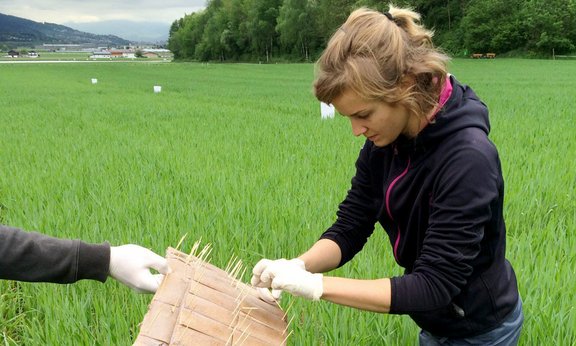Previous research on the prevalence of non-pest predators and pests had not successfully answered the question as to whether the former actually prey on the latter. The FWF project enabled scientists “to look into the black box that is the food web for the first time. We are starting to understand how the system works, because we were able to observe the behaviour of different species and their interactions”, explains the principal investigator Michael Traugott. The team employed a complex methodology to obtain these insights. With the support of the FWF, a six-strong research team investigated the impact of different types of fertiliser on biological pest control. They were assisted by a number of motivated and trained undergraduate students; and even by school classes taking part in the Sparkling Science programme.
Exploring nature’s household management
Working in cooperation with a local secondary school of agronomics (HBLFA Kematen) and four famers, the research team set up their experiment in six fields with winter cereal crops near Kematen in Tyrol. They explored the relationship between pests and predators after applying farm-produced fertiliser consisting of manure, compost and commercial fertiliser (conventional inorganic fertiliser with nitrogen, phosphate and potassium). One unfertilised field served as a control. The experiment ran for two years on 60 8×8 metre test plots and involved two sampling dates per year: the first in late May, when the aphids invade the wheat fields and the predators – thus hope the farmers – are lying in wait and ready to eat the first breeding females in order to stem pest proliferation. The second sampling took place when the aphid population was at its peak in mid/late June.
In each test plot, the teams recorded everything found crawling or flying on the plants. After sampling the insectoid fauna with the help of suction traps, sticky traps and pitfall traps, the scientists determined the species. Four days before the sampling, fences were erected around each plot to limit the scope of prey of these highly mobile predators. Molecular gut content analysis was then used to identify the pests eaten by the predators (spiders and ground beetles) in the previous few days. In order to find out how reliably spiders and ground beetles decimate the aphid population, the researchers set up mesh cages around individual plants to keep them free of pests. After the first sampling, a specific number of aphids – according to the average pest count of each plot – were placed on the cage-protected plants. The cage then prevented predators from reaching the plant until the second sampling had taken place, and the pests were left undisturbed.
The workings of the food web
Every fertiliser changes the composition of the variety of species and the scope of prey: “We knew that manure promotes alternative prey, i.e. non-pest organisms that the beneficial predators also like to eat. After evaluating all parameters we now know for certain that manure still offers the most stable level of pest control, even if other environmental factors are modified”, is how the ecologist explains the key results of this basic research project. The second grain pest examined was the larva of the cereal leaf beetle, which predators rarely prey on. “The outcome sounds simple, but it is extremely valid because we factored in many different aspects. Manure is a good strategy for fertilisation in organic farming, because it allows for robust pest control and better predictability of how successful the measures taken will be”, explains Michael Traugott.
The scientists also found short-term measurable changes in pest control without any major changes in the diversity of species found to be present on the plots. “Although the same species live in the test plots, they do different things, thus leading to a different outcome”, says Traugott. The researcher assumes that the impact will be more effective if a field is treated with manure for a period of several years.
(Red./scilog)

